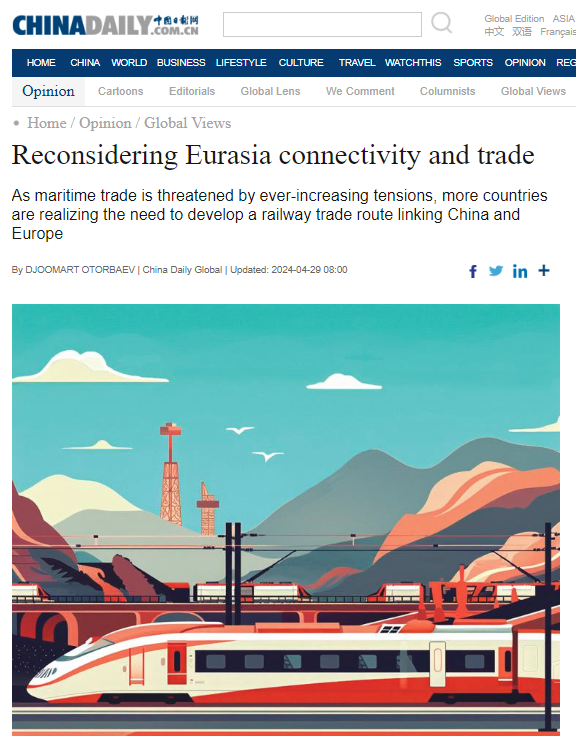LATEST INSIGHTS
Your Present Location: LATEST INSIGHTSDjoomart Otorbaev: Reconsidering Eurasia connectivity and trade
Source: China Daily Published: 2024-04-29

The recent conflict between Israel and Iran has not only escalated tensions in the Middle East but also emerged as a severe and imminent threat to the global order, including maritime shipping. Given the pivotal role of shipping in international trade, these developments can potentially disrupt supply chains and significantly impact the global economy.
Geopolitical and climate concerns have triggered a series of unprecedented disruptions in global supply chains, particularly along vital maritime trade routes. These disruptions, from the COVID-19 pandemic, the Ever Given incident in the Suez Canal, the persistent drought in the Panama Canal, the hostilities in the Black Sea, to the ongoing attacks on commercial ships in the Red Sea by the Houthi rebels, have sent shock waves through the global economy. With 90 percent of goods still reliant on sea transport, the potential impact on the worldwide economy is not just a cause for concern, but an immediate crisis, threatening to exacerbate inflation and other significant economic issues. Industries such as automotive, electronics, and fashion, which rely heavily on just-in-time delivery, are particularly affected.
While the shipping industry is undergoing numerous crises, rail transportation across the Eurasian landmass is thriving and developing rapidly. According to statistics released by the China State Railway Group, freight traffic on the China-Europe route reached 17,523 trips in 2023, carrying 1.902 million twenty-foot equivalent units of goods, representing yearly increases of 6 and 18 percent, respectively.
Among these, 9,343 trips were westbound, and 8,180 were eastbound. The number of China-Europe freight train trips reached 2,928 in the first two months of 2024, up 9 percent year-on-year. During this period, the route carried 317,000 TEUs, up 10 percent from the year before.
The railway route now connects 120 Chinese cities with 219 cities in 25 European countries. The China-Europe railway is an intelligent and environmentally friendly means of transporting freight. The share of capital-intensive and time-sensitive products such as photovoltaic modules, new energy vehicles, lithium-ion batteries, electronics, machine parts, jewelry and plastic products is proliferating.
The soft infrastructure for such transportation is being improved at a rapid pace. 'On the China-Europe Express Railway routes, customs clearance and inspection are becoming more convenient, the business environment at ports of entry is constantly improving, and the rules and regulations related to cross-border transportation are becoming more standardized,' Chinese Foreign Ministry spokesman Mao Ning said at a press conference on Feb 29. For example, port facilities were expanded at two railway crossings between China and Kazakhstan, and customs procedures were optimized, reducing train stopping time to six to eight hours.
The rail connections are not just growing. They are becoming more resilient and adaptable. Today, trains take about 10 days to travel 9,908 kilometers from Xi'an in Shaanxi province to Duisburg in Germany, two days less than in 2023. Average carbon dioxide emissions during this journey are 15 times less than air travel and 10 times less than road transport, making it a more sustainable and secure option for global trade.
If rail transport in the Eurasian continent continues to grow, the obvious beneficiaries will be the landlocked Central Asian countries, as they will have direct access to both the Chinese and European markets, as well as the markets of the South Caucasus and Turkiye. Being a transport bridge between Asia and Europe, Kazakhstan remains the only beneficiary of the growing traffic among the Central Asian countries. In addition to the direct benefit of being able to trade directly with Asia and Europe, Kazakhstan Railways generated a revenue of $4.2 billion and a net profit of $344 million last year, with year-over-year growth of 29.3 percent and 400 percent, respectively.
The planned construction of the China-Kyrgyzstan-Uzbekistan railway will allow three more countries, including Turkmenistan, to access direct and transit rail trade. These countries are particularly interested in developing railway trade along the shortest so-called Middle Corridor, which links China and Europe via Central Asia, the Caspian Sea, the South Caucasus, and Turkiye. The European Union has expressed its readiness to support such a project and invest 10 billion euros ($10.66 billion) in constructing the Middle Corridor.
One of the drawbacks of using this corridor is the requirement to cross the Caspian Sea, which is both costly and time-consuming. This drawback can be addressed through the utilization of cutting-edge technologies, such as drawing upon China's extensive experience in ferrying trains across the ocean.
The sustainable development of maritime trade is threatened by ever-increasing geopolitical tensions, military escalation in the oceans, increasing regional fragmentation, and the need to reduce the carbon footprint. At the same time, the quality and efficiency of rail transport are growing. The world of trade is constantly changing, and keeping up with these changes is essential. Global trade restructuring is both necessary and urgent. Humanity must adapt to the changing political and economic landscape to reshape trade and stay ahead of the curve. Governments and businesses must take these steps quickly to build a prosperous future for all.
The author is former prime minister of the Kyrgyz Republic and a distinguished professor at the Belt and Road School at Beijing Normal University. The author contributed this article to China Watch, a think tank powered by China Daily. The views do not necessarily reflect those of China Daily.























































































 京公网安备 11010802037854号
京公网安备 11010802037854号





